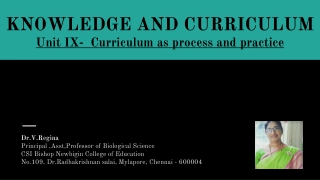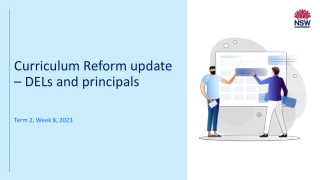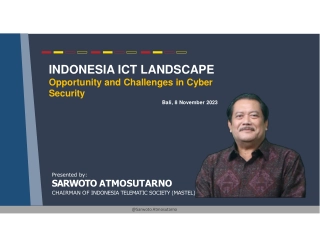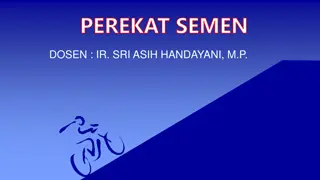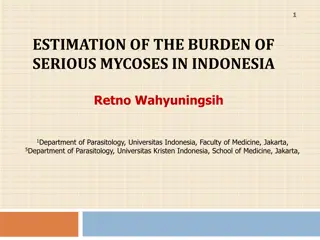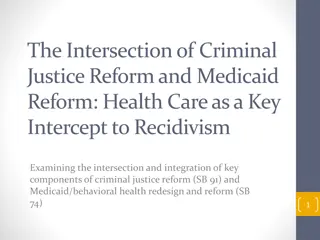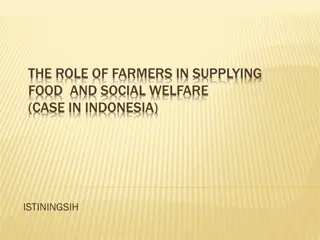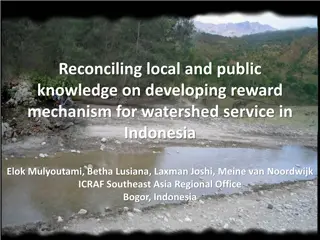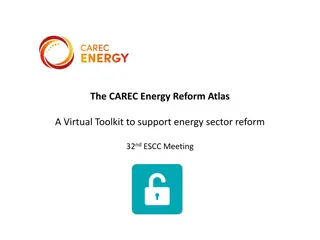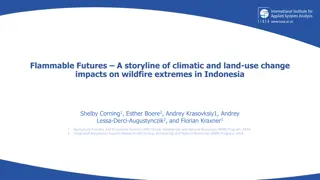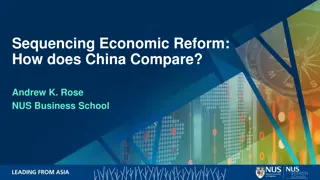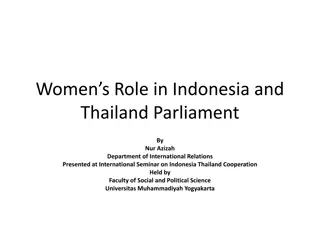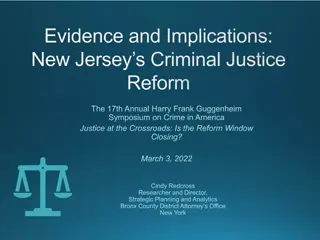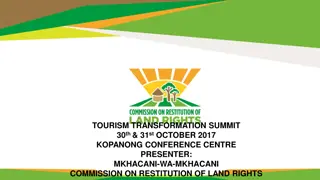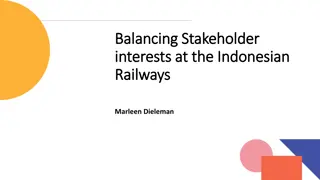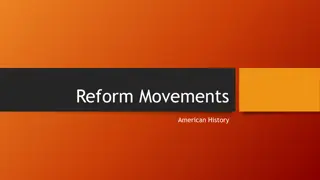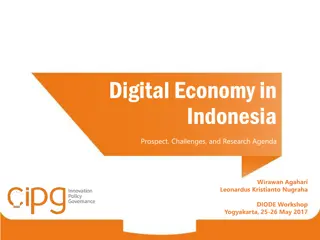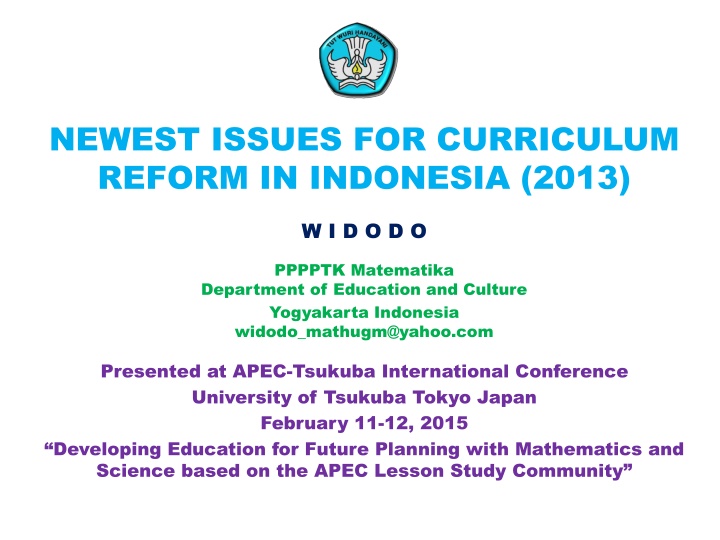
Issues in 2013 Curriculum Reform in Indonesia
The 2013 curriculum reform in Indonesia focuses on changes in graduates' competence, process, material evaluation, and holistic construction. It emphasizes attitudes, skills, and knowledge development based on competence characteristics. The curriculum integrates various subjects vertically and horizontally, utilizing authentic assessment methods and prioritizing discovery learning and project-based learning.
Download Presentation

Please find below an Image/Link to download the presentation.
The content on the website is provided AS IS for your information and personal use only. It may not be sold, licensed, or shared on other websites without obtaining consent from the author. If you encounter any issues during the download, it is possible that the publisher has removed the file from their server.
You are allowed to download the files provided on this website for personal or commercial use, subject to the condition that they are used lawfully. All files are the property of their respective owners.
The content on the website is provided AS IS for your information and personal use only. It may not be sold, licensed, or shared on other websites without obtaining consent from the author.
E N D
Presentation Transcript
NEWEST ISSUES FOR CURRICULUM REFORM IN INDONESIA (2013) W I D O D O PPPPTK Matematika Department of Education and Culture Yogyakarta Indonesia widodo_mathugm@yahoo.com Presented at APEC-Tsukuba International Conference University of Tsukuba Tokyo Japan February 11-12, 2015 Developing Education for Future Planning with Mathematics and Science based on the APEC Lesson Study Community
Curriculum Concept Reform in Indonesia (2013)
Curriculum Development in Indonesia 1975 Primary School Curriculum 2004 Competence Based Curriculum (CBC) Pioneer 1947 Lesson Plan Specified in Lesson Plan Elaboration 1994 1994 Curriculum 1968 Primary School Curriculum 2013 2013 Curriculum 1985 1965 1945 1955 1975 1995 2005 2015 1984 1984 Curriculum 2006 Unit Level of Education Curriculum (ULEC) 1973 Developmen School Pioneer Project (DSPP) Curriculum 1997 1994 Curriculum Revision 1964 Primary School Education Plan
CURRICULUM (2013) CHANGES IN THE FORM OF: GRADUATES COMPETENCE PROCESS MATERIAL EVALUATION Oriented to competence characteristics: Holistic Construction Supported By All Materials or Courses Integrated Vertically and Horizontally Exam and Non- Exam (portfolio) Based Evaluate Process and Output using authentic assesment Report card contains quantitative evaluation of knowledge and qualitative descriptions of attitude and skill sufficiency Attitude (Krathwohl) : Accepting + Responding + Valuing + Internalizing + Actualizing Skills (Dyers) : Observing + Questioning + Experimenting + Associating + Communicating+ Creating Knowledge (Bloom & Anderson): Knowing + Understanding + Applying + Analyzing + Evaluating + Creating Using Scientific Approach, Competence Characteristics based on Grades (Primary School: Integrated Thematic, Junior High School: Integrated Thematic - Science & Social Science- and Subjects, Senior High School: Thematic and Subjects Prioritizing on Discovery Learning and Project Based Learning Developed Based on Competence to Fulfill Suitability and Sufficiency Aspects Accomodate Local, National, and InternationalContent (such as TIMMS, PISA, PIRLS)
Curriculum Development Framework *never stop learning Psychology Pedagogy Socio-eco-cultural Learning Faithful, pious, noble individual Successful Learner Confident Individual Responsible Citizen Effective Civilization Contributor Competent Graduate Student Readiness: -Physical -Emotional -Intellectual -Spiritual Requirement: -Individual -Society, Nation, Country, World -Civilization Feasibility: -Material -Delivery Method -Evaluation Method Curriculum (SKL/Graduate competency standards, Curriculum Structure, Standards: Content, Process, and Evaluation) Academic Climate and Education Unit Culture Management and Leadership Handbook (Student Handbook, Teacher Handbook) Teacher Competency Formulation and Teacher Preparation
Educational Reform Refers to 8 Standards 2013 Curriculum Curriculum evaluation process standard G G R R A A D D U U A A T T E E S S Graduation competency standards Underway Core Standards L L E E A A R R N N E E R R Learning process standard Done and keep worked on educators standard education personnel Qualification Improvement & Certification Certification Aid Payment Competency Evaluation and Performance Measurement infrastructure standard financing standard management standards School Building Rehabilitation Laboratory and Library Supply Book Provisioning BOS Poor Students Aid BOPTN/Bidik Misi (for University) School Based Management
CURRICULUM DEVELOPMENT DIMENSIONS 2013 CURRICULUM PHILOSOPHY: UU Sisdiknas Pasal 1 Butir 1 dan 2 : Education Itself: Students are actively developing their potential to have the competencies that are rooted in religious values, national culture of Indonesia and responsive to the demands of the changing times. EDUCATIONAL PHILOSOPHIES Perrenialism Essentialism Progressivism Reconstructionism RPJMN 2010-2014 EDUCATIONAL SECTOR Learning Methodology Changes Curriculum Regulation INPRES NOMOR 1 TAHUN 2010 Implementation of National Development Priorities Acceleration: Completion of curriculum and active learning methods based on the values of the nation's culture to shape the nation's competitiveness and character CURRICULUM EVALUATION: Context and Purpose Determination Model Selection Implementation Curriculum Revision CURRICULUM DEVELOPMENT THEORY: UU Sisdiknas Pasal 4 : principles, systems, processes, culture, design, and quality control. Pasal 3 : function (developing skills and shaping character and civilization) Working skills-based theory content organization and competence as an adult individual ownership of attitudes, skills, holistic knowledge, or formal, valuational and praxeology. N o 1. 1. Standard Commentary CURRICULUM BASIC STRUCTURE AND FRAMEWORK DEVELOPED UNDER THE RELEVANCE ASPECTS (Pasal 38 UU Sisdiknas) Graduate Graduate Competency Competency Developed According To The Demands Of The Present And The Future Of Indonesia As Needed. Parsed By The Adequacy And Suitability With Competence. Designed With A Competency-based Scientific Approach Exam And Non-exam (Portfolio) Based 2. 2. Content Content 3. 3. Process Process 2013 CURRICULUM (KBK): Standard Improvements : GRADUATE COMPETENCY, CONTENT, PROCESS, and EVALUATION 4. 4. Evaluation Evaluation
2013 CURRICULUM BOOK DEVELOPMENT STRATEGY SKL : Graduate competency standards L E S S O N T E X T B O O K LEARNING PROCESS LEARNING MATERIAL CORE COMPETENCY EVALUATION BASIC COMPETENCY
INTER-GRADE APPROACH ....... 2013 curriculum is an integrated effort of (1) reconstruction of graduate competency, with (2) suitability & sufficiency, broadness & depth of materials, (3) educational revolution and (4) evaluation reform ....... University Senior High School Junior High School THEMATIC + SUBJECTS THEMATIC + SUBJECTS Primary School INTEGRATED THEMATIC + SUBJECTS INTEGRATED THEMATIC
Reconstruction of Graduate Competency, Material, Process and Evaluation
Purpose of National Education (Pasal 3 UU No 20 Sisdiknas Tahun 2003) To develop students' potential to become faithful and pious man, noble, healthy, knowledgeable, skilled, creative, independent, and also to become democratic and responsible citizen. Spiritual Attitude Social Attitude Knowledge Skill Faithful and Pious healthy, independent, democratic and responsible, etc knowlegeable skilled and creative, etc
Balance between attitude, skills and knowledge to develop soft skills and hard skills1 University Senior High School Skill Knowledge Attitude Junior High School Primary School Source: Marzano (1985), Bruner (1960).
Standard Graduate Competence Scope and its process Creating Characterizing/ Actualizing Communicating Evaluating Organizing/ Internalizing Associating Analyzing Experi- menting Valuing Applying Responding Questioning Understanding Accepting Observing Knowing Attitude (Krathwohl) Skill (Dyers) Knowledge (Bloom)
Learning Process that Supports Creativity Dyers, J.H. et al [2011], Innovators DNA, Harvard Business Review: 2/3 of one s creativity acquired from education, the other 1/3 is genetic. The opposite is true for Intelligence: 1/3 from education, 2/3 genetic. Creativity acquired from: - Observing - Questioning - Associating - Experimenting - Networking Intelligence-based learning will not have significant result (only 50% improvement) compared to creativity-based one (up to 200%) Personal Inter-personal The need to formulate a curriculum based on learning process that emphasizes personal experience through the process of observing, questioning, associating, and experimenting [observation based learning] to increase students creativity. Moreover, students familiarized to networking through collaborative learning 15
Evaluation Process that Supports Creativity Sharp, C. 2004. Developing young children s creativity: what can we learn from research?: Teacher can make students behave creatively using: problems which has many ways to answer, tolerating peculiar answers, emphasizing on the process rather than result, encourging students to try, to determine which information is unclear, to have their own interpretation of a knowledge or observed event balancing structured and spontaneous/expresive events The need to formulate a curriculum containing evaluation process that emphasizes on the process and result so that portfolio-based evaluation (problem which has many answers, tolerating peculiar answers, evaluating the process together with the result, spontaneous/expressive evaluation, etc.) is needed 16
Shaping High Order Thinking Ability Since Early Stages Center on the Developing Child, Harvard University [2011]. Building the Brain ATC System: How Early Experiences Shape the Development of Executive Function. The architecture of the brain is formed by layers of tissue containing neurons that are related to each other The network is formed since early age, although it is still developing until the age of 30, the development is not as fast as children's The complexity of the network determines the level of a person's thinking ability [low order of thinking skills for routine functions to high order of thinking skills for executive decision making functions] It is required a learning system that can build the high order thinking skills capacity [by finding out rather than being informed] from the early ages through freedom to determine what kind of activities to do The need to formulate curriculum that emphasizes on process observing, questioning, associating, concluding and deciding so that from early ages, students are skilled in high order thinking which will be needed for executive decision making 17
Standard Competence of Graduates Main Competence, and Basic Competence
STANDARD COMPETENCE OF GRADUATES - BRIEF DOMAIN PRIMARY SCHOOL JUNIOR HS SENIOR HS Accepting + Implementing + Respecting + Appreciating + Practicing PERSON WHO HAS FAIH, NOBLE, CONFIDENT AND RESPONSIBLE IN INTERACTING EFFECTIVELY WITH SOCIAL ENVIRONMENT, THE NATURE AROUND AND THE WORLD WITH ITS CIVILISATION ATTITUDE Observing+ Asking + Experimenting + Reasoning + Presenting + Creating PERSON CAPABLE OF THINKING AND FOLLOWING PRODUCTIVELY AND CREATIVELY IN THE FIELD ABSTRACT AND CONCRETE SKILLS Knowing + Understanding + Applying + Analyzing + Evaluating + Creating PERSONAL WHO MASTERS SCIENCE, TECHNOLOGY, ARTS, CULTURE AND HUMANITY , NATIONALITY, STATE INSIGHTS, AND CIVILIZATION KNOWLEDGE Gradation between Education Unit attention; 1. Psychological development of children 2. The scope and depth of the material continuity 3. The function of the educational unit 4. The Environment
Standard Graduate Competence (SGC) - Brief SGC Main Competence ATTITUDE AND BEHAVIOR: Accepting + Implementing + Respecting + Appreciating + Practicing Appreciate and practice the teachings of their religion Develop behavior (honest, discipline, responsibility, caring, polite, environmently friendly, mutual aid, cooperation, peace-loving, responsive and pro-active) and demonstrate behaviors as part of a solution to the various problems of the nation to interact effectively with the social and natural environment and in placing itself as a reflection of the nation in the association world. 1. Faith, morality (honest, discipline, responsibility, caring, polite), curiosity, aesthetics, confident, internal motivation 2. Tolerance, mutual cooperation, collaboration, and consensus 3. Healthy lifestyle, environment friendly, patriotic, and love of peace Understand and apply factual knowledge, conceptual, procedural in science, technology, art, culture, and humanities with human insight, national, state, and civilization-related phenomena and events, as well as apply the procedural knowledge in a specific field of study according to their talents and interests to solve the problem. SKILLS: Observing+ Questioning + Trying + Processing + Presenting + Reasoning + Creating 1. Reading, writing, counting, drawing, writing 2. Use, parse, compose, modify, making, creating Processing, reasoning, and presenting in the realm of concrete and abstract domains associated with the development of whats is learned in school independently, and is able to use the method according to the rules of science. KNOWLEDGE: Knowing + Understanding + Applying + Analyzing + Evaluating 1. Science, technology, art, and culture 2. Humans, nation, state, country, and world
Competency linkages between levels of education Formulation Process Aim of National Education KI KI Kelas VI GC UNIV Kelas VI KI KI Kelas V SHS/VS/M A GC Kelas V KI KI Kelas IV GC JHS/MTs Kelas IV KI KI Kelas IIII GC PS/MI Kelas IIII Formation Process Mata Pelajaran Mata Pelajaran Mata Pelajaran Mata Pelajaran Core Competence Set Mata Pelajaran Mata Pelajaran Mata Pelajaran Mata Pelajaran Mata Pelajaran Mata Pelajaran Basic Competence Set Mata Pelajaran Mata Pelajaran Mata Pelajaran Mata Pelajaran Mata Pelajaran Mata Pelajaran Subject GC: Graduate Competence
The Linkage between graduate compotence, core competence and subjects for primary school FORMULATION PROCESS Kompetensi Lulusan Lulusan Graduate Competence KI KI KI Kompetensi GC Kelas VI Kelas VI Kelas VI Grade KI KI KI GC Kelas V Kelas V Kelas V Grade KI KI KI VI Kelas IV Kelas IV Kelas IV Kelas IV KI GC KI KI GC V Kelas IIII Kelas IIII Kelas IIII Grade KI KI KI GC Kelas II Kelas II Kelas II Grade KI KI KI Formation Process IIII Kelas I Kelas I Kelas I Grade I GC II Mata Pelajaran Mata Pelajaran Mata Pelajaran Mata Pelajaran Mata Pelajaran Mata Pelajaran CORE COMPETENCE SET Mata Pelajaran Mata Pelajaran Mata Pelajaran Mata Pelajaran Mata Pelajaran Mata Pelajaran Subject GC: Graduate Competence
STANDARD COMPETENCE PRIMARY SCHOOL GRADUATES BASED ON 2013 CURRICULUM Attitude Have [through receiving, implementing, cherishing, appreciating, practicing] behavior that reflects the attitude of the faithful, noble character [to be honest, polite, caring, disciplined, democratic], confident, and responsible for interacting effectively with the social and natural environment, around the home, school, and play area Skills Have [through observing, asking, trying, processing, presenting, reasoning, creating] the ability of thinking and act productively and creatively in the realm of the abstract and the concrete in accordance with that assigned to him. Knowledge MHave [through knowing, understanding, applying, analyzing, evaluating] factual and conceptual knowledge based on curiosity about science, technology, art, and culture in human insight, national, state, and civilization-related phenomena and events in the home, school , and playground
STANDARD COMPETENCE JUNIOR HIGH SCHOOL GRADUATES BASED ON 2013 CURRICULUM Attitude Have [through receiving, implementing, respect, appreciate, practice] behavior that reflects the attitude of the faithful, noble [honest, polite, caring, disciplined, democratic], confident, and responsible to interact effectively with the social and natural environment in range interaction Skill Have [through observing, asking, trying, processing, presenting, reasoning, creating] the ability of thinking and effectively and creatively in the realm of the abstract and the concrete in accordance with what is learned in school and other similar sources Knowledge Have [through knowing, understanding, applying, analyzing, evaluating] factual knowledge, conceptual, and procedural based on curiosity about science, technology, art, culture in human insight, national, state, and civilization-related phenomena and events that can be seen with our eyes
STANDARD COMPETENCE SENIOR HIGH SCHOOL GRADUATES BASED ON 2013 CURRICULUM Attitude Have [through receiving, implementing, respecting, appreciating, practicing] behavior that reflects the attitude of the faithful, noble [honest, polite, caring, disciplined, democratic, patriotic], confident, and responsible to interact effectively with the social environment and nature as well as in established itself as a reflection of the nation in the world s association Skill Have [through observing, asking, trying, processing, presenting, reasoning, creating] the ability of thinking and act effectivly and creatively in the realm of the abstract and concrete as the development of the independently studied in school [in a specific field of study] according to their talents and interests Knowledge Have [through knowing, understanding, applying, analyzing, evaluating] procedural and metacognitive knowledge based on curiosity about science, technology, art, culture in human insight, national, state, and civilization-related causes of phenomena and events [in the specific field of study ] according to their talents and interests
STANDARD COMPETENCE VOCATIONAL SCHOOL GRADUATES BASED ON 2013 CURRICULUM Attitude Have [through receiving, implementing, respecting, appreciating, practicing] behavior that reflects the attitude of the faithful, noble [honest, polite, caring, disciplined, democratic, patriotic], confident, and responsible to interact effectively with the social environment and nature as well as in established itself as a reflection of the nation in the world s association Skills Have [through observing, asking, trying, processing, presenting, reasoning, creating] the ability of thought and act effectively and creatively in the realm of the abstract and concrete as the development of the independently studied in school [in specific work areas] in accordance with their talents and interests Knowledge Have [through knowing, understanding, applying, analyzing, evaluating] procedural and metacognitive knowledge in science, technology, art, culture with human insight, national, state, and civilization-related causes of phenomena and events [in specific work areas] in accordance talent and interest
Mathematics No Previous Curriculum Current Curriculum 1 Go directly to abstract material Starting from the observation of concrete problems, then to the semi-concrete, and finally abstraction problem The formula derived by the students and the issues proposed must be workable for students with only formulas and basic understanding (not only use but also to understand its origin) Balance between math with numbers and without numbers [images, graphics, patterns, etc.] 2 Many formulas to be memorized to resolve the problem (can only be use) 3 Mathematical problems were associated with the [reduced to] numbers Not accustom students to think critically [only mechanistic] Unstructured method of problem solving Data and statistics introduced in class IX only 4 Designed so that students must think critically to solve the problems posed 5 Accostuming students to algorithmic thinking 6 Extending material includes opportunities, data processing, and statistics from class VII and other materials in accordance with international standards Introduce the concept of the approach and estimates 7 Mathematics is exact
Problem 1 Problem 1: Given the sequence of pictures: If = 1, then (a). How many squares in the 1st picture (b). How many squares in the 2nd picture (c). How many squares in the 3rd pucture (d). How many squares in the 4th picture (e). How many squares in the 5th picture (f). How many squares in the n th picture
Problem 2 Problem 2: Given the sequence of pictures: If = 1, then (a). How many squares in the 1st picture (b). How many squares in the 2nd picture (c). How many squares in the 3rd pucture (d). How many squares in the 4th picture (e). How many squares in the 5th picture (f). How many squares in the n th picture
Problem 3 Problem 3: Given the sequence of pictures: If = 1, then (a). How many squares in the 1st picture (b). How many squares in the 2nd picture (c). How many squares in the 3rd pucture (d). How many squares in the 4th picture (e). How many squares in the 5th picture (f). How many squares in the n th picture
Science No Previous Curriculum Current Curriculum 1 The learning material is presented separately in Physics, Chemistry, and Biology The learning material is presented integrated , no more separation between Physics, Chemistry, and Biology 2 No platform, all studies stand in line Use Biology as a study platform with consideration of all natural events and phenomena associated with the objects and their interactions among these objects. The goal is to emphasize the importance of interaction of biology, physics, chemistry and their combinations in forming a stable bond. 3 Earth and space science materials is still inadequate [partly discussed in Social] Completed with earth and space science materials in accordance with international standards 4 The material tend to be superficial and memorizable The material enriched with the needs of students to think critically and analytically in accordance with international standards 5 Learning materials were taught by different teachers (team teaching) with certification based on the Learning materials are taught by a teacher who gives an insight into the integrated subject area so that students can understand the importance of integration between subjects before studying them in detail separately in the
Indonesian/English Language No Previous Curriculum Current Curriculum 1 Learning material was focused on grammar Learning material is focused on language competence as a media of communication to convey idea and knowledge 2 Students were not accustomed to read and understand the meaning of the text presented Students are accustomed to read and understand the meaning of the text as well as summarizing and presenting again with its own language 3 Students were not accustomed to compose a systematic, logical, and effective text Students are accustomed to compose systematic, logical, and effective text through exercises 4 Students are introduced to the appropriate text rules so as not to confuse in writing a text (according to the situation: who, what, where) Students are not introduced on the rules of text for the real needs 5 Less emphasis on the importance of language expression and spontaneity Students are accustomed to express himself and his knowledge using convincing language spontaneously
Social Science No Previous Curriculum Current Curriculum 1 The material is presented separately in Geography, History, Economics, Sociology Material presented in integrated, not separated into groups of Geography, History, Economics, Sociology. 2 No platform, all studies stand in line Geography is used as the study platform by considering that all events and activities are tied to the location. The goal is to emphasize the importance of the unity in strengthening the National Republic of Indonesia. The study history, sociology, culture, and economics are meant to support the formation of the stronger unity. 3 Learning materials was taught by different teachers (team teaching) with certification based on the subject. Learning materials are taught by a teacher who gives an integrated insight between subjects so that students can understand the importance of the integration, before learning it in detail and separately in the next education level.
Pancasila and Civics No Previous Curriculum Current Curriculum 1 Learning materials were presented based on four separated pillars. Learning materials are not presented based on the four pillars of nationality grouping but based on the integration of the four pillars in forming the national character 2 Learning materials were presented based on the existing supply on the four pillars of nationality. Learning materials are presented based on the need to be a responsible citizen (obey the norms, principles, and rules) 3 There was no emphasis on action as a good citizen existence of competence required from students to take real action as a good citizen 4 Pancasila (Five principles) dan civics was presented as a knowledge to memorize Pancasila (Five principles) dan civics is not merely a memorizable knowledge but applied in the real action and daily life.
General Book Concept on Curriculum 2013 Referring to the core competencies that have been formulated for the intended class Explaining knowledge as an input to the students to produce an output in the form of student skills and end with forming the students attitudes as learning outcomes Using a scientific approach through observing, asking, trying, reasoning, and presenting Encourage students to find a concept being learnt deductively [discovery learning]. Students are encouraged as much as possible to find out, not directly informed Covering the assessment of learning outcomes gradually from the review, exercise, the problem, challenge, and project. Emphasizing the use of clear, logical and systematic language. Skills are not always in the area of abstract, but also must be concrete in the form of real action
Examples of Core Competence Grade Primary School Area of Competence Core Competence Accepting and applying the religion they believe. Spiritual Attitude Having behavior of honest, discipline, responsible, polite, caring, and confident in interacting with family, friends, and teachers. Understanding the factual knowledge by observing [listening, seeing, reading] and asking based on curiosity about himself, God's creation and its activities, and the objects he encountered at home and in school Presenting factual knowledge in clear and logical, in the form of aesthetic work, the movement reflecting a healthy child, and the actions reflecting the behavior of the faithful, noble, and knowledgeable child. Social Attitude Knowledge Skill
Primary School Books Thematic integrative books Activity based, covering daily activities planning Students worksheet (at the end of theme will be the students portfolio) Each series of learning (sub-themes) begins with a stimulus to observe and ask about the surroundings in line with sub-themes being discussed (arranged in the form of clear, logical, and systematic text ) In the next step, begins with learning the clear language text [written / oral] in accordance with sub-themes and materials that will be discussed The first grader is supposed to be ready with reading, writing and counting Accustomed to observe the pattern (numeric and forms) and understanding the rules in forming them Language understanding should be prioritisized than the other material Knowledge is being a topic in understanding language, thus students easily understand both language and knowledge. Showing the importance of data and its presentation. Mathematics is not always link to numeric and counting Sport dan art, culture, skill correspond to the discussed materials (math, science and others) Skills should also be in concrete actions not just an abstract Each theme should be ended with project
Junior High School Books on Curriculum 2013 No Curriculum 2013 1 Each subject supports all competences [attitude, skill, knowledge) 2 Subject is designed interrelated one another and having the basic competence tied with core competence in each class. 3 All subjects are taught using the same approach; scientific approach through observing, asking, trying and thinking. 4 Students assignment is related to the students skill 5 Prioritizes the discussion based on themes 6 ICT is a tool of learning, used as the learning media for all subjects.
MP Junior High School Curriculum Concept Social Science Learning materials are presented an integrated, not separated into groups of Geography, History, Economics, Sociology. Geography is used as a platform to demonstrate the diversity to form connectivity linking supply and demand. Discussion is based on the kinds of resources for development. Geology is not part of social science Science Learning materials are presented an integrated, not separated in physics, chemistry, biology. Biology is used as a platform to describe other disciplines. Referring to international standards (PISA, TIMSS) both based on its broad and depth, Science covers earth and space sciences. The discussion is based on the basic principles of life in the universe [interaction, energy, transformation, etc.]. Avoiding calculation [the formula], emphasizing mastery of concepts and experiments. Mathem atics Referring to international standards (PISA, TIMSS,) both its broad and dept, starting with concrete problems gradually brought into the form of an abstract (model). Emphasizing the importance of the procedure [algorithm] in problem solving. Covering the numbers, algebra, form, data and chances in balance; it is not always exact, can be approximate; and not always have complete information to be completed Indonesia Language Referring to international standards (PIRL,); Text-based, balanced between written and oral. Emphasizing the importance of language as a communication tool to convey ideas and knowledge. Master the competencies about text: composing [by 48
MP Junior High School Curriculum Concept Civics Presented integrated, not based on the four pillars of nationality grouping but based on the integration of the four pillars in forming the nation character. The material is presented based on the need to become a responsible citizen (obey norms, principles, and rules); students are required to have competence in taking real action as a good citizen [actively involved in the development of society]. Englis Designed in the same way as Indonesia language with the emphasis on Indonesian ditto with an emphasis on conversation, reading, writing practices. Assuming that the students have not been formally studied English at the time of grade VII entry. Art and Culture Students are given the knowledge and basic techniques mastery, thus they will be fond of art and culture to increase the sensitivity and appreciation to the art and culture product and value. Understanding the diversity and uniqueness of every aspect of the art in order to feel the beauty of the product and the value of art and culture. Skill Students are equipped with enough knowledge about materials, processes, and tools along with the resources necessary to produce a masterpiece. Applying this knowledge to be skilled in working with an effective and efficient manner by analyzing the materials, processes, and tools required Sports The integration between physical education, sports, and health. Not only skill, but there must be an underlying knowledge, and attitudes that must be formed through PJOK/sports subject. Put forward an interesting game not exercise with 49
Example in Scotland : Purposes of The Curriculum http://www.scotland.gov.uk/Publications/2004/11/20178/45862

